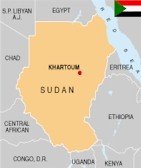
The year before independence, a civil war began between Northern and Southern Sudan. The Southerners, anticipating independence, feared the new nation would be dominated by the North.
Historically, the north of Sudan had closer ties with Egypt and was predominantly Arab and Muslim while the south was predominantly black, with a mixture of Christianity and Animism. These divisions had been further emphasized by the British policy of ruling the North and South under separate administrations. From 1924 on it was illegal for people living above the 10th parallel to go further south and for people below the 8th parallel to go further north. The law was ostensibly enacted to prevent the spread of malaria and other tropical diseases that had ravaged British troops, as well as to prevent Northern Sudanese from raiding Southern tribes for slaves. Another reason was to facilitate spreading christianity among the predominantly animist population while stopping the arabic and islamic influence from advancing south. The result was increased isolation between the already distinct north and south and arguably laid the seeds of conflict in the years to come.
The resulting conflict, known as the First Sudanese Civil War, lasted from 1955 to 1972. In 1972, a cessation of the north-south conflict was agreed upon under the terms of the Addis Ababa Agreement, following talks which were sponsored by the World Council of Churches. This led to a ten-year hiatus in the national conflict
Historically, the north of Sudan had closer ties with Egypt and was predominantly Arab and Muslim while the south was predominantly black, with a mixture of Christianity and Animism. These divisions had been further emphasized by the British policy of ruling the North and South under separate administrations. From 1924 on it was illegal for people living above the 10th parallel to go further south and for people below the 8th parallel to go further north. The law was ostensibly enacted to prevent the spread of malaria and other tropical diseases that had ravaged British troops, as well as to prevent Northern Sudanese from raiding Southern tribes for slaves. Another reason was to facilitate spreading christianity among the predominantly animist population while stopping the arabic and islamic influence from advancing south. The result was increased isolation between the already distinct north and south and arguably laid the seeds of conflict in the years to come.
The resulting conflict, known as the First Sudanese Civil War, lasted from 1955 to 1972. In 1972, a cessation of the north-south conflict was agreed upon under the terms of the Addis Ababa Agreement, following talks which were sponsored by the World Council of Churches. This led to a ten-year hiatus in the national conflict










